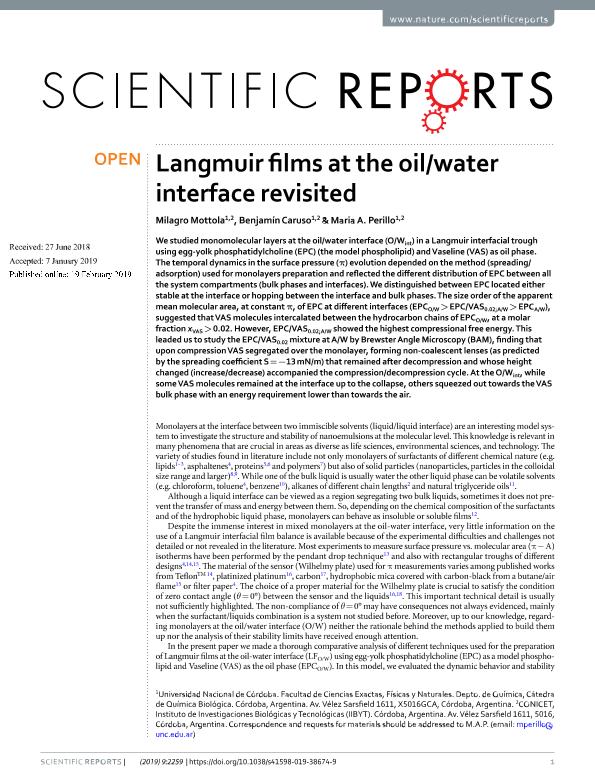Artículo
Langmuir films at the oil/water interface revisited
Fecha de publicación:
12/2019
Editorial:
Nature Publishing Group
Revista:
Scientific Reports
ISSN:
2045-2322
Idioma:
Inglés
Tipo de recurso:
Artículo publicado
Clasificación temática:
Resumen
We studied monomolecular layers at the oil/water interface (O/W int ) in a Langmuir interfacial trough using egg-yolk phosphatidylcholine (EPC) (the model phospholipid) and Vaseline (VAS) as oil phase. The temporal dynamics in the surface pressure (π) evolution depended on the method (spreading/adsorption) used for monolayers preparation and reflected the different distribution of EPC between all the system compartments (bulk phases and interfaces). We distinguished between EPC located either stable at the interface or hopping between the interface and bulk phases. The size order of the apparent mean molecular area, at constant π, of EPC at different interfaces (EPC O/W > EPC/VAS 0.02;A/W > EPC A/W ), suggested that VAS molecules intercalated between the hydrocarbon chains of EPC O/W , at a molar fraction x VAS > 0.02. However, EPC/VAS 0.02;A/W showed the highest compressional free energy. This leaded us to study the EPC/VAS 0.02 mixture at A/W by Brewster Angle Microscopy (BAM), finding that upon compression VAS segregated over the monolayer, forming non-coalescent lenses (as predicted by the spreading coefficient S = −13 mN/m) that remained after decompression and whose height changed (increase/decrease) accompanied the compression/decompression cycle. At the O/W int , while some VAS molecules remained at the interface up to the collapse, others squeezed out towards the VAS bulk phase with an energy requirement lower than towards the air.
Palabras clave:
Langmuir films
,
Liquid-liquid interface
,
Monomolecular layers
Archivos asociados
Licencia
Identificadores
Colecciones
Articulos(IIBYT)
Articulos de INSTITUTO DE INVESTIGACIONES BIOLOGICAS Y TECNOLOGICAS
Articulos de INSTITUTO DE INVESTIGACIONES BIOLOGICAS Y TECNOLOGICAS
Citación
Mottola, Milagro; Caruso, Benjamin; Perillo, Maria Angelica; Langmuir films at the oil/water interface revisited; Nature Publishing Group; Scientific Reports; 9; 1; 12-2019
Compartir
Altmétricas




